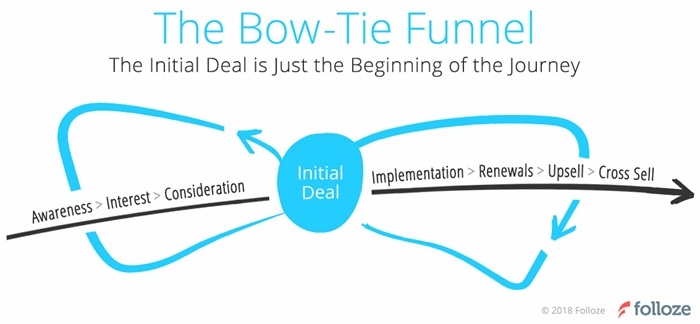If you have kids, you may know the Bop It! game. If you don't... picture a portable gaming unit (a joystick of sorts) that tests your reaction time when performing a series of commands. Those commands are in random order, and players need to respond correctly and as quickly as possible, or they're out of the game.
You're asking, What exactly does this have to do with marketing?
Well, Bop It! reminds me of the many new go-to-market (GTM) strategies that have emerged because of the need to move away from the antiquated linear marketing and sales funnel, as originally defined by William W. Townsend—soon to celebrate its 95th birthday. Sales and marketing teams are trying all different approaches, but whether they flip the funnel, turn it, or "bop it" (the choice of my nine-year-old), the traditional funnel doesn't properly reflect how most B2B GTM's run.
The main issue? It doesn't encompass the way buyers behave, the way purchasing decisions are made, or the way customer engagement should be designed. Buying cycles for today's complex global enterprises are more multidimensional and spiral-like, with a continuum of purchasing decisions made over the customer's lifecycle. Typically, the initial sale is just the beginning: 80+% of organizational revenue actually comes later.
That's because in today's digital marketplace, where more is sold "as a service," companies can "try and buy," thus leaving most of their lifetime value on the table for future purchases.
Particularly in the case of software, businesses can purchase fewer licenses and test-drive a product or service without making a long term or expensive commitment. Many industries are shifting to a Cloud-like services model that allows this.
Moreover, with everything from human interactions to business transactions being measurable, the "trial model" empowers buyers to require tangible ROI before expanding.
It's not bad news, though. There is a way to win in this environment.
The Bow Tie: A Funnel for Continuous Marketing
So, in this world, where customers start small and grow, what does it mean specifically for marketing? Most marketing activities today occur before the sale, versus after the win, which right off the bat creates a major disconnect between investment and generated revenue. Instead of thinking of customers as "exiting the funnel" once a deal is signed, marketers should model the entire customer lifecycle in terms of a "Bow Tie" Funnel" to optimize for and sustain revenue growth.
The Bow Tie methodology—essentially an infinity loop for marketing efforts wherein a customer is always treated like a prospect—ensures that marketers, together with Sales, are providing value and engaging at each stage of the relationship: before, during and after the sale.
That's a fundamental concept ingrained in account-based marketing.

Opening the doors to new customers is important, but so is widening the door for existing customers. In a sense, marketing needs to prepare or trigger the next sale, similar to the Nir Eyal's model of hooked triggering events for user adoption and habit creation. Marketing needs to think about the customer lifetime value holistically—from initial sales, to loyalty, to expansion via upsell, and ultimately to renewal and through this cycle again.
Post-Initial Sales Approaches: The Right Side of the Bow Tie
Marketers who don't use the Bow Tie typically focus solely on the left side—creating awareness and measuring interest levels. However, there are several key post-sale areas that marketers should capitalize on.
For example, when a new customer need is identified via a sales interaction, data analysis or marketing insight, marketers can take customer relationships to the next level, create growth opportunities, and eventually turn them to brand evangelists.
Below are a few Bow Tie right-side opportunities to explore, allowing marketers to "trigger" the next revenue generating customer event:
- Implementation: Larger and more complex deployments often need consulting and professional services after initial setup. Be on the lookout for opportunities to offer support, mainly in the form of marketing created education and guidance.
- Renewal: Automatic renewals may be easier for rebilling, but manual renewals provide an opportunity to cross-sell or upsell. Use the renewal process as a way to offer new services.
- Expansion and upsell: Happy clients make the best referrals. Harness your successful client relationships as the basis for expansion suggestions. Suggest additional offerings during the account evaluation, or mention other departments within the organization that could also benefit from your solutions.
- Cross-sell: Identify opportunities to share complementary products to what customers are already using or evaluating, and thus expand the deal.
Programs to Implement to Trigger the Next Sale
There are some real-world tactics that can yield impressive outcomes for your business:
- Send educational newsletters from Sales. One of our customers continuously educates prospective buyers and stays top of mind by sending monthly newsletters via account executives. It's important to take a consultative approach to content to gain trust as an adviser. Also use third-party content, such as analyst reports and industry blogs, that are rich in information; they, too, can lend credibility.
- Prepare for upsell. Another customer identified an upsell opportunity, but, instead of abruptly springing it on the buyer, created an educational campaign that started a month beforehand. By placing a strong focus on trend education rather than on the product, the company was successful.
- Host webinars focused on specific stages. Successful marketers run webinars for groups of existing accounts that are at the same stage of the Bow Tie Funnel—for example, "have purchased Product X and are looking to roll it out globally." This approach allows you to be very targeted with webinar content, providing immense value to customers.
- Provide knowledge-sharing opportunities. Provide opportunities for customers to talk to each other in the vein of a dedicated customer community. Whether via customer forums or informal one-to-ones, peer interaction can go a long way. One of the ground rules is to stay on the sidelines: Facilitate the discussion, but don't run it.
- Send end-of-year summaries. Some companies routinely communicate value and ROI to customers; that's the hook for the next sale. Organizations that create end-of-year campaigns to demonstrate the success of the past year and plans for the next are frontrunners in earning the customer's trust.
Beyond the Bow Tie
To evolve into a high-performing GTM team, marketers can enlist other tactics. The first includes formulating a different engagement model with Sales, something talked about a lot in forming ABM strategy: Instead of handing off leads to Sales, Marketing needs to be fully involved in the sales process.
Harnessing customer data is also key to value-driven marketing. Because we know so much more about customers than prospects—such as key stakeholders, their business goals, challenges, usage patterns, and more—it's imperative to incorporate this data into marketing campaigns to make them more personalized, relevant, and effective.
Finally, because people buy from people, position a dedicated contact on the front lines. Customers already have a relationship with the account and/or customer success manager, so that person must be at the forefront of every marketing activity: People interact with people—not just with a brand.




